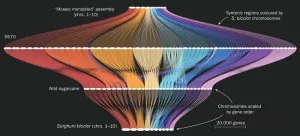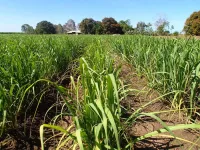Until now, sugarcane’s complicated genetics made it the last major crop without a complete and highly accurate genome. Scientists have developed and combined multiple techniques to successfully map out sugarcane’s genetic code. With that map, they were able to verify the specific location that provides resistance to the impactful brown rust disease that, unchecked, can devastate a sugar crop. Researchers can also use the genetic sequence to better understand the many genes involved in sugar production.
The research was conducted as part of the Community Science Program at the U.S. Department of Energy Joint Genome Institute (JGI), a DOE Office of Science user facility at Lawrence Berkeley National Laboratory (Berkeley Lab). The study is published today in the journal Nature, and the genome is available through the JGI’s plant portal, Phytozome.
“This was the most complicated genome sequence we’ve yet completed,” said Jeremy Schmutz, Plant Program lead at the JGI and faculty investigator at the HudsonAlpha Institute for Biotechnology. “It shows how far we’ve come. This is the kind of thing that 10 years ago people thought was impossible. We’re able to accomplish goals now that we just didn't think were possible to do in plant genomics.”
Sugarcane’s genome is so complex both because it is large and because it contains more copies of chromosomes than a typical plant, a feature called polyploidy. Sugarcane has about 10 billion base pairs, the building blocks of DNA; for comparison, the human genome has about 3 billion. Many sections of sugarcane’s DNA are identical both within and across different chromosomes. That makes it a challenge to correctly reassemble all the small segments of DNA while reconstructing the full genetic blueprint. Researchers solved the puzzle by combining multiple genetic sequencing techniques, including a newly developed method known as PacBio HiFi sequencing that can accurately determine the sequence of longer sections of DNA.
Having a complete “reference genome” makes it easier to study sugarcane, enabling researchers to compare its genes and pathways with those in other well-studied crops such as sorghum or other biofuel crops of interest, like switchgrass and miscanthus. By comparing this reference to other crops, it becomes easier to understand how each gene influences a trait of interest, such as which genes are highly expressed during sugar production, or which genes are important for disease resistance. This study found that the genes responsible for resistance to brown rust, a fungal pathogen that previously caused millions of dollars of damage to sugarcane crops, are found in only one location in the genome.
“When we sequenced the genome, we were able to fill a gap in the genetic sequence around brown rust disease,” said Adam Healey, first author of the paper and a researcher at HudsonAlpha. “There are hundreds of thousands of genes in the sugarcane genome, but it’s only two genes, working together, that protect the plant from this pathogen. Across plants, there are only a handful of instances that we know of where protection works in a similar way. Better understanding of how this disease resistance works in sugarcane could help protect other crops facing similar pathogens down the road."
Researchers studied a cultivar of sugarcane known as R570 that has been used for decades around the world as the model to understand sugarcane genetics. Like all modern sugarcane cultivars, R570 is a hybrid made by crossing the domesticated species of sugarcane (which excelled in sugar production) and a wild species (which carried the genes for disease resistance).
“Knowing R570’s complete genetic picture will let researchers trace which genes descended from which parent, enabling breeders to more easily identify the genes that control the traits of interest for improved production,” said Angélique D’Hont, last author of the paper and a sugarcane researcher at the French Agricultural Research Center for International Development (CIRAD).
Improving future varieties of sugarcane has potential applications in both agriculture and bioenergy. Enhancing how sugarcane produces sugar could increase the yield farmers get from their crops, providing more sugar from the same amount of growing space. Sugarcane is an important feedstock, or starting material, for producing biofuels, particularly ethanol, and other bioproducts. The residues that remain after the pressing of sugarcane, referred to as bagasse, are an important type of agricultural residue that can also be broken down and converted into biofuels and bioproducts.
“We are working to understand how specific genes in plants relate to the quality of the biomass we get downstream, which we can then turn into biofuels and bioproducts,” said Blake Simmons, Chief Science and Technology Officer for the Joint BioEnergy Institute, a DOE Bioenergy Research Center led by Berkeley Lab. “With a better understanding of sugarcane genetics, we can better understand and control the plant genotypes needed to produce the sugars and bagasse-derived intermediates we need for sustainable sugarcane conversion technologies at a scale relevant to the bioeconomy.”
This study involved collaborations with institutes from around the world, including France (CIRAD, UMR-AGAP, ERCANE); Australia (CSIRO Agriculture and Food, Queensland Alliance for Agriculture and Food Innovation/ARC Centre of Excellence for Plant Success in Nature and Agriculture - University of Queensland, Sugar Research Australia); Czech Republic (Institute of Experimental Botany of the Czech Academy of Sciences); and the United States (Corteva Agriscience, Joint BioEnergy Institute). The genome was sequenced at the JGI with work completed at the JGI partner laboratories, the Arizona Genomics Institute and the HudsonAlpha Institute for Biotechnology.
The Joint Genome Institute is a Department of Energy Office of Science User Facility. The Joint BioEnergy Institute is a DOE Bioenergy Research Center.
###
Lawrence Berkeley National Laboratory (Berkeley Lab) is committed to delivering solutions for humankind through research in clean energy, a healthy planet, and discovery science. Founded in 1931 on the belief that the biggest problems are best addressed by teams, Berkeley Lab and its scientists have been recognized with 16 Nobel Prizes. Researchers from around the world rely on the lab’s world-class scientific facilities for their own pioneering research. Berkeley Lab is a multiprogram national laboratory managed by the University of California for the U.S. Department of Energy’s Office of Science.
DOE’s Office of Science is the single largest supporter of basic research in the physical sciences in the United States, and is working to address some of the most pressing challenges of our time. For more information, please visit energy.gov/science.
END







